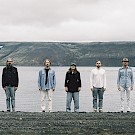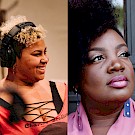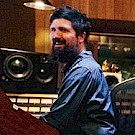Fresh off a frenetic spring punctuated by a headlining show at the now-defunct Alhambra Theatre, an opening slot for funk legend George Clinton, and a two-week tour of California, neo-soul collective Dirty Revival have no plans for respite. The ever-occupied Portland five-piece just held down a prominent slot at the 4 Peaks Music Festival in Bend on July 19 as they continue to put the finishing touches on their self-titled studio debut, which was recorded at Tucker Martine’s (The Decemberists, Neko Case) Flora Recording & Playback.
Interviewed upon their return from the Joshua Tree Music Festival—the spring tour’s climactic performance—group members Sarah Clarke (vocals), Terry Drysdale (drums), Karl Ludwigsen (keyboards), Jon Shaw (bass), and Evan Simko (vocals and guitar) recall the experience of playing before a capacity crowd while opening for George Clinton (see a gallery of photos from that show by Paul Garcia), and reflect on their recent tour before closing with an album status report as they prep for this fall’s official release event on Friday, September 11 at Portland’s Mississippi Studios.
I know the past few months have been pretty eventful for the band. Tell me about the George Clinton show! How did that opportunity come about?
Sarah Clarke: We had been working with Alex Wideman, who’s one of the McMenamins bookers. He had been booking us at the White Eagle—pretty much exclusively—and then gave us the opportunity to play at the Crystal Ballroom’s 101st birthday event. Then after that, we just got a random email! It was totally out of the blue. Jon [Shaw] just loves the funk music, so he wasn’t upset about that! Everyone else was pretty mad. [Laughs]
I know the band has a lot of experience as an opening act, but did you feel like it took anything extra to really reach a crowd of that magnitude? Did it bring a different dynamic to the performance?
Terry Drysdale: Oh, hell yeah!
Clarke: The crowd was in it from the get-go! I think, for us—at least for me—I can say that I’ve never been that nervous before a show. And I hadn’t taken a look at the crowd or any of that. The guys were kind of peeking through and taking pictures and stuff before we went on, but I was so fucking freaked out!
But when we got on stage, everyone was just so immediately involved and they made it super easy to deliver, you know? It was super helpful.
So you guys were feeling it once you hit the stage?
Karl Ludwigsen: Yeah, once the downbeat hit.
Drysdale: And the stage sound was really good. It was one of those moments where everything was working, and either we tapped into the energy of the crowd, or they tapped into our energy, or a combination of both.
 George Clinton at the Crystal Ballroom—click to see a whole gallery of photos by Paul Garcia
George Clinton at the Crystal Ballroom—click to see a whole gallery of photos by Paul Garcia
Do any of you guys have particular memories of that show? Did anyone meet George Clinton?
Clarke: No!
Drysdale: He was like a phantom!
Clarke: They had everything blocked out, and everything just smelled like weed. And that was all we knew about that. We knew he was in there somewhere. There was a lot of security and weed smell, and we were like: “That must be where George Clinton is!” [Laughs]
Evan Simko: I gave the bass player a pick and asked him what group he was in, because they were soundchecking and doing a hip-hop set. I thought it was an opening set for George Clinton—like they were touring with him. He asked for a pick, and I was like, “What group are you playing with? I heard some stuff up there.” He was like, “George Clinton...” “Oh, shit! I thought you were doing hip-hop, my bad.” [Laughs]
Clarke: I wasn’t expecting that, either. I can see how you could be confused. How embarrassing for you! [Laughs]
Simko: He was chill, though. He liked our set—I talked to him afterwards.
That’s awesome. So you got a good response from them?
Clarke: Yeah—in passing, mostly. The sax player approached us a few times, and he was really nice.
 Dirty Revival's Evan Simko at the Crystal Ballroom—click to see a whole gallery of photos by Paul GarciaYou guys also had your first headlining gig at the Alhambra, right?
Dirty Revival's Evan Simko at the Crystal Ballroom—click to see a whole gallery of photos by Paul GarciaYou guys also had your first headlining gig at the Alhambra, right?
Clarke: That was actually our second! We’d headlined an Alhambra show in the smaller room a year before that. That was sold out too.
Does the band feel pretty comfortable headlining shows at this point?
Clarke: We’ve gotten a lot better at it. Now we play a lot of shows where it’s just us, so it was just kind of like any other show. The expectation of playing for two hours maybe would have been super daunting a year ago, whereas now, it really isn’t.
Ludwigsen: We’ve had to stretch songs, though.
Does headlining require a significant change in mindset? You’re going from playing all-out for half an hour to having to fill two hours while holding the audience’s attention.
Clarke: I think it’s certainly different. It’s more pressure when you’re headlining. When you get a lot of good acts opening up for you, you’ve got to bring it.
Drysdale: I mean, how many concerts have you gone to where you watched the opening or support acts and then you get to the headliner, and half way through the headliner, you’re like, “That was better than the main event.” It’s not super common, but that’ll happen. We don’t want that to happen!
Clarke: But at the same time, support slots are really great. A 45-minute set is a perfect amount of time for us. We can make a set list without question marks in it and play all of our heavy hitters. And that’s kind of nice. So they both have their advantages. It’s very different.
How would a headlining set differ in structure? Would you start out with a few heavier, faster numbers and then dial it back for a while before ramping up to conclude?
Clarke: Yeah, we kind of have our formula. We’ll start with a short instrumental and do a little bit of talking—talk to the audience and kind of feel everybody out—then usually a more common song. Usually, we do “Problems” and some of the music that’s more recognizable to people up front, just to kind of draw them in.
We’re still perfecting the set list. Because in some ways, it would make sense to put all the slow stuff in the middle. Yet, that actually doesn’t make sense, because then everyone’s just standing there for 30 minutes, like “Okay.” And they’re not bored—if the music is good, it’s not boring.
So you have to control that ebb and flow a little bit.
Clarke: Yeah. I would say that we still haven’t figured that out perfectly yet. But I think that’s totally normal—trying to find the perfect mix of music. You can think you have a perfect set list, and you get there, and it’s like, “What does the crowd want?”
Will the band change up a set list on the fly pretty often?
Drysdale: All the time.
Clarke: At the end of the tour, we got really good at doing that—being flexible and just kind of moving stuff around. It became a lot easier. I think that before we went on the road together, every decision would take a lot longer on stage.
You just have to be flexible. It’s a major thing. And when you’re headlining a show, or doing the entire show, where it’s just a Dirty Revival show, you just have to kind of give the crowd what it wants and make it work.
Ludwigsen: That also tells us what we need in terms of songs.
Drysdale: Yeah. Coming away from the tour, we all were coming home and we were like, “Oh man, we need more of this; we need less of that.”
 Dirty Revival at the Crystal Ballroom—click to see a whole gallery of photos by Paul Garcia
Dirty Revival at the Crystal Ballroom—click to see a whole gallery of photos by Paul Garcia
I saw that the tour ended with an appearance at the Joshua Tree Music Festival. Did that present a new performance dynamic?
Clarke: I’ve never played a festival like that before. It was like what you’d think—it was in the middle of the desert with a bunch of hippies. [Laughs] It was super awesome.
I’ve just never been in that type of environment. It was really interesting to get that, and it was really fun to play. It was a different situation. It was daytime, and the sun was shining. We’re not really used to that. But we just got up there and had a fucking blast. It was so much fun.
Every stage is different, and every stage presents its own set of problems. We were on a big stage, which is sometimes challenging for us since we’re used to cramming on really small stages. Normally, we’ve got great communication most of the time because we’re so close to each other. So it came with its own set of problems, but that’s all part of it. I think every performance is going to be like that in some way.
Let’s talk about the new record for a bit. Did that tour give you an opportunity to road test some of the new songs? Did a lot of them make into the set list?
Clarke: Everything made it in except for two tracks, maybe three. We have a hip-hop track that we do with Elton Cray that we don’t do unless he’s with us. And we’ve played that song one time—we played it at the Alhambra gig.
We have another song that we’ve never actually performed live. Our intention was to work it up so we could play it at Joshua Tree, and just the circumstances didn’t quite work out. The night before in L.A., we were going to try to add it—it was the night before Joshua Tree. I was so sick, though, so it didn’t work out.
Simko: We almost had to cut that gig short, but we were able to fill it out a little bit.
Drysdale: There were a couple moments where we finished a song, and Sarah had to get offstage. She was like, “Instrumental time! You guys are up. I’m going to go throw up now.”
Did you find that the new songs changed a bit as they were adapted to a live context?
Clarke: I think a lot of the time they were actually pretty similar and pretty true unless we had to extend them. I mean, the tunes are the tunes. Sometimes, we stretch things out if we’re faced with three-hour sets or something.
Simko: We had some we’d been playing in the studio that solidified for sure. Otherwise, it’s just opening things up for solos. And the studio kind of helped us decide how we were going to do certain parts.
Getting back to the record itself, where are things at right now?
Clarke: We’re doing a lot of editing. In fact, on June 4, we had a pretty long editing session with Paul [Laxer] and knocked out as much as we could. We’re probably going to have to get in the studio one more time. We still have some horn work to do: We still have some string work to do, and we still have some synth work to do.
So there’s some logistical stuff there, but the end is definitely in sight. I mean, I’d say that 70 percent of the tracks sound really good and need fine-tuning and the rest of them need some work.
Is there a release date yet?
Clarke: We were able to lock down Mississippi Studios on September 11 with Redray Frazier as our support act for the album release event. He’s freaking phenomenal—a really awesome local soul act. We also have another couple of surprises but you’re going to have to wait for the show to find out!
But it’s going to be great. I’m really, really looking forward to that. The best part about it is that our producer, Paul, does sound at Mississippi Studios. So after spending so long working on this album, he gets to handle the sound! [Laughs]
Is the record going to come out on vinyl as well?
Drysdale: Yeah, a limited release!
That’s really cool.
Clarke: Having all of that in our hands and being able to tour more is really our main goal right now. We had a really great time in California, and it worked out really well for us. They already want us to come back. [Check out DR's just announced Cali dates in August.] We’d like to be on the road as much as we can to spread the word. And we have several exciting things in the works for 2016 that might actually take us outside of the U.S.!











